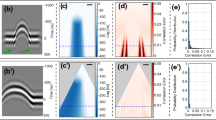Abstract
This paper reports a pulse inversion chirp coded tissue harmonic imaging (PI-CTHI) method for visualizing small animal hearts that provides fine spatial resolution at a high frame rate without sacrificing the echo signal to noise ratio (eSNR). A 40 MHz lithium niobate (LiNbO3) single element transducer is employed to evaluate the performance of PI-CTHI by scanning tungsten wire targets, spherical anechoic voids, and zebrafish hearts. The wire phantom results show that PI-CTHI improves the eSNR by 4 dB from that of conventional pulse inversion tissue harmonic imaging (PI-THI), while still maintaining a spatial resolution of 88 and 110 μm in the axial and lateral directions, respectively. The range side lobe level of PI-CTHI is 11 dB lower than that of band-pass filtered CTHI (or F-CTHI). In the anechoic sphere phantom study, the contrast-to-noise ratio of PI-CTHI is found to be 2.7, indicating a 34% enhancement over conventional PI-THI. Due to such improved eSNR and contrast resolution, blood clots in zebrafish hearts can be readily visualized throughout heart regeneration after 20% of the ventricle is removed. Disappearance of the clots in the early stages of the regeneration has been observed for 7 days without sacrificing the fish.












Similar content being viewed by others
References
Arshadi, R., A. C. H. Yu, and R. S. C. Cobbold. Coded excitation methods for ultrasound harmonic imaging. Can. Acoust. 35:35–46, 2007.
Averkiou, M. A. Tissue harmonic imaging. IEEE Ultrason. Symp. 2:1563–1572, 2000.
Bakkers J. Zebrafish as a model to study cardiac development and human cardiac disease. Cardiovascular Res., 2011. doi:10.1093/cvr/cvr098.
Borsboom, J. M. G., T. C. Chien, A. Bouakaz, M. Versluis, and N. de Jong. Harmonic chirp imaging method for ultrasound contrast agent. IEEE Trans. Ultrason. Ferroelectr. Freq. Control 52:241–249, 2005.
Cherin, E. W., J. K. Poulsen, A. F. W. Van Der Steen, P. Lum, and F. S. Foster. Experimental characterization of fundamental and second harmonic beams for a high-frequency ultrasound transducer. Ultrasound Med. Biol. 28:635–646, 2002.
Chiao, R. Y., and X. Hao. Coded excitation for diagnostic ultrasound: a system developer’s perspective. IEEE Trans. Ultrason. Ferroelectr. Freq. Control 52:160–170, 2005.
Frijlink, M. E., D. E. Goertz, A. Bouakaz, and A. F. W. van der Steen. A simulation study on tissue harmonic imaging with a single-element intravascular ultrasound catheter. J. Acoust. Soc. Am. 3:1723–1731, 2006.
Hauff, P. Small Animal Imaging: Basics and Practical Guide. Berlin: Springer, pp. 119–124, 2006.
Hauff, P. Small Animal Imaging: Basics and Practical Guide. Berlin: Springer, pp. 207–217, 2006.
Hohl, C., T. Schmidt, P. Haage, D. Honnef, M. Blaum, G. Staatz, and R. W. Guenther. Phase-inversion tissue harmonic imaging compared with conventional B-mode ultrasound in the evaluation of pancreatic lesions. Eur. Radiol. 14:1109–1117, 2004.
Johnstone, E., S. E. Friedl, A. Maheshwari, and G. S. Abela. Distinguishing characteristics of erythrocyte-rich and platelet rich thrombus by intravascular ultrasound catheter system. J. Thromb. Thrombolysis 24:233–239, 2007.
Jopling, C., E. Sleep, M. Raya, M. Marti, A. Raya, and J. C. I. Belmonte. Zebrafish heart regeneration occurs by cardiomyocyte dedifferentiation and proliferation. Nature 464:606–609, 2010.
Kanagaratnam, P., S. P. Gogineni, V. Ramasami, and D. Braaten. A wideband radar for high-resolution mapping of near-surface internal layers in glacial ice. IEEE Trans. Geosci. Remote Sens. 42:483–490, 2005.
Karaman, M., P. C. Li, and M. O’Donnell. Synthetic aperture imaging for small scale systems. IEEE Trans. Ultrason. Ferroelectr. Freq. Control 42:429–442, 1995.
Kim, D. Y., J. C. Lee, S. J. Kwon, and T. K. Song. Ultrasound second harmonic imaging with a weighted chirp signal. IEEE Ultrason. Symp. 2:1477–1480, 2001.
Laflamme, M. A., and C. E. Murry. Heart regeneration. Nature 473:326–335, 2011.
Madsen, E. L., G. R. Frank, M. M. McCormick, M. E. Deaner, and T. A. Stiles. Anechoic sphere phantoms for estimating 3-D resolution of very-high-frequency ultrasound scanners. IEEE Trans. Ultrason. Ferroelectr. Freq. Control 57:2284–2292, 2010.
Misaridis, T., and J. A. Jensen. Use of modulated excitation signal in medical ultrasound. Part I: basic concepts and expected benefits. IEEE Trans. Ultrason. Ferroelectr. Freq. Control 52:177–191, 2005.
Park, J., C. H. Hu, and K. K. Shung. Stand-alone front-end system for high frequency, high-frame-rate coded excitation ultrasonic imaging. IEEE Trans. Ultrason. Ferroelectr. Freq. Control 58:2620–2630, 2011.
Poss, K. D., L. G. Wilson, and M. T. Keating. Heart regeneration in zebrafish. Science 298:2188–2190, 2002.
Ramo, M. P., T. Spencer, P. P. Kearney, S. T. R. D. Shaw, I. R. Starkey, W. N. McDicken, and K. A. A. Fox. Characteristics of red and white thrombus by intravascular ultrasound using radiofrequency and videodensitometric data-based texture analysis. Ultrasound Med. Biol. 23:1195–1199, 1997.
Song, J., S. Kim, H. Sohn, T. Song, and Y. M. Yoo. Coded excitation for ultrasound tissue harmonic imaging. Ultrasonics 50:613–619, 2010.
Sun, L., X. Xu, W. D. Richard, C. Feng, J. A. Johnson, and K. K. Shung. A high-frame rate duplex ultrasound biomicroscopy for small animal imaging in vivo. IEEE Trans. Biomed. Eng. 55:2039–2049, 2008.
Üstüner, K. F., and G. L. Holley. Ultrasound imaging system performance assessment. In: Presented at the 2003 American Association of Physicists in Medicine Annual Meeting, San Diego, CA, August 2003.
Acknowledgment
This work has been supported by NIH Grants R01-HL79976 and P41-EB2182 and the National Research Foundation of Korea (NRF) grant funded by the Korea government (MEST) (No. 2012R1A1A1015778).
Author information
Authors and Affiliations
Corresponding author
Additional information
Associate Editor Jeffrey L. Duerk oversaw the review of this article.
Electronic supplementary material
Below is the link to the electronic supplementary material.
Rights and permissions
About this article
Cite this article
Park, J., Huang, Y., Chen, R. et al. Pulse Inversion Chirp Coded Tissue Harmonic Imaging (PI-CTHI) of Zebrafish Heart Using High Frame Rate Ultrasound Biomicroscopy. Ann Biomed Eng 41, 41–52 (2013). https://doi.org/10.1007/s10439-012-0636-y
Received:
Accepted:
Published:
Issue Date:
DOI: https://doi.org/10.1007/s10439-012-0636-y




